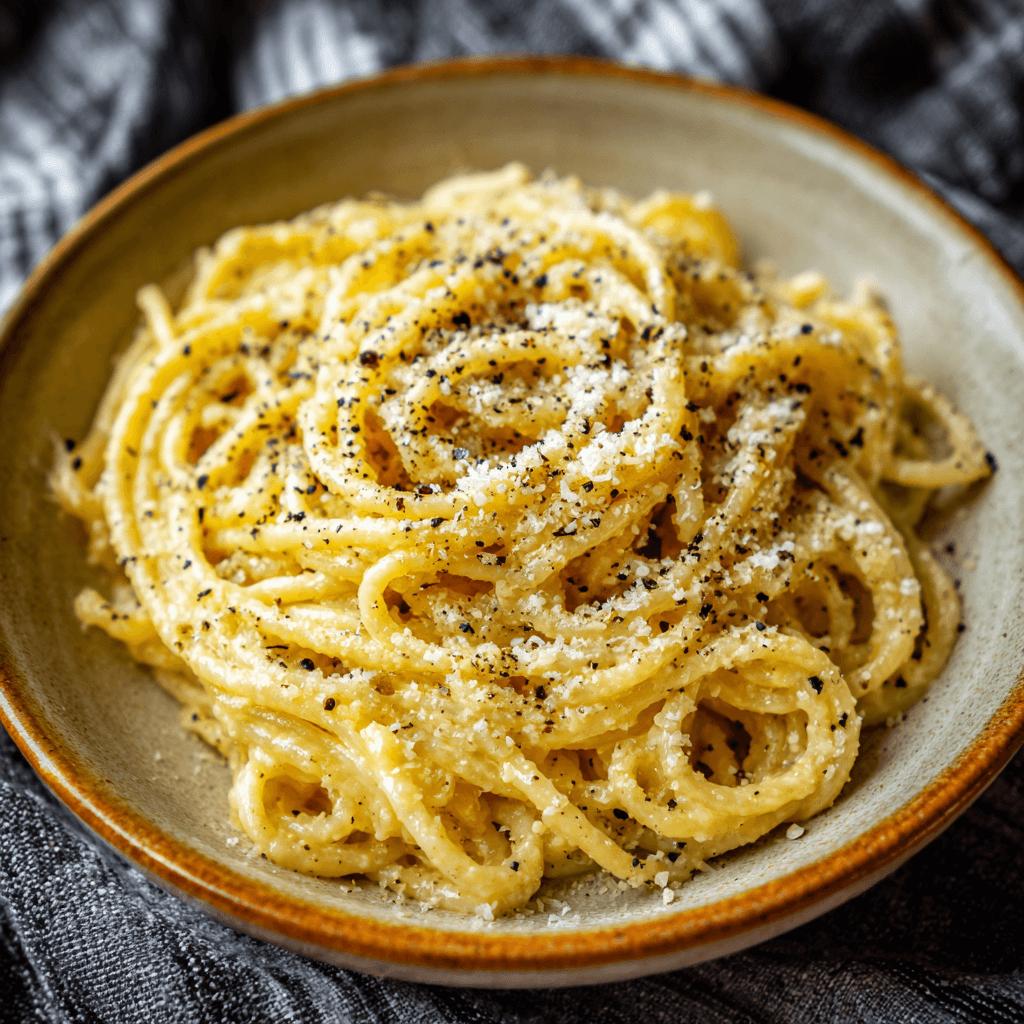Introduction
Cacio e Pepe is a beloved Roman pasta dish that exemplifies the elegance of simplicity. With only three core ingredients—pecorino Romano cheese, black pepper, and pasta—it showcases how a few quality components can come together to create something truly unforgettable. Known for its creamy texture without the use of cream, this dish relies on emulsification techniques and a bit of kitchen magic to achieve its signature velvety sauce.
The History
Cacio e Pepe traces its roots back to ancient Rome, where it was a staple among shepherds who needed hearty, long-lasting meals made from simple ingredients. The name itself gives away its origins: “Cacio” refers to cheese (specifically Pecorino Romano), and “Pepe” means pepper. Over time, the dish became a favorite in Roman cuisine and eventually gained popularity across Italy and beyond. Its rustic charm and depth of flavor have earned it a permanent spot in Italian culinary tradition.
Ingredients Breakdown
- Pasta: Traditionally, spaghetti is used, but tonnarelli or bucatini are also popular choices due to their texture and ability to hold onto the sauce.
- Pecorino Romano Cheese: Aged and salty, this sheep’s milk cheese is essential for achieving the rich, umami-packed sauce.
- Black Pepper: Freshly ground black peppercorns provide heat and aromatic complexity; they’re often cracked coarsely for texture and flavor.
Step-by-Step Recipe
- Cook the Pasta: Bring salted water to a boil and cook your pasta until al dente. Reserve a cup of pasta water before draining.
- Grind the Pepper: While the pasta cooks, grind a generous amount of black peppercorns into a fine powder or coarse grind depending on your preference.
- Make the Emulsion: In a bowl, whisk together grated Pecorino Romano cheese and a few tablespoons of pasta water until smooth and creamy.
- Combine Everything: In a pan over low heat, add some pasta water and the cooked pasta. Pour in the cheese mixture while stirring constantly. Add more pasta water as needed to reach a creamy consistency.
- Taste and Adjust: Season with additional pepper if needed, and serve immediately while hot and creamy.
Tips
- Use Quality Ingredients: Since there are so few ingredients, each one should be top-notch—especially the cheese and pepper.
- Don’t Boil the Sauce: To avoid curdling the cheese, always remove the pan from the heat when adding the cheese mixture.
- Reserve Pasta Water: Starchy pasta water is crucial for creating the emulsion. Don’t skip saving at least a cup.
- Work Quickly: This dish comes together fast, so have all your ingredients ready before you start cooking.
Variations and Customizations
- Add Garlic: Some chefs like to infuse olive oil with garlic for added depth.
- Incorporate Greens: Sautéed spinach or kale can be folded in for a nutritious twist.
- Try Different Cheeses: If Pecorino isn’t available, Parmigiano Reggiano is a suitable substitute, though it will change the flavor profile slightly.
- Spice It Up: For a kick, add a pinch of crushed red pepper flakes along with the black pepper.
Health Considerations and Nutritional Value
Cacio e Pepe is naturally high in protein thanks to the cheese and pasta. However, it is also relatively high in saturated fat and sodium due to the cheese. To make it lighter:
- Use Whole Grain Pasta: Adds fiber and complex carbohydrates.
- Reduce Cheese Quantity: Still delicious with a little less cheese.
- Boost with Vegetables: Adding steamed or sautéed veggies increases fiber, vitamins, and minerals.
Per serving (approx. 1 cup pasta, ¼ cup cheese, 1 tsp pepper): ~400–500 calories, 15–20g protein, 15–20g fat, 50–60g carbs.
Ingredients
- 400g (14 oz) spaghetti or bucatini
- 100g (1 cup) finely grated Pecorino Romano cheese
- 1 tablespoon freshly ground black pepper (plus more to taste)
- Salt to taste (for pasta water)
- Reserved pasta water (as needed)
Directions
- Bring a large pot of salted water to a boil. Cook the pasta according to package instructions until al dente. Reserve 1 cup of pasta water before draining.
- While the pasta cooks, grind the black peppercorns into a coarse or fine powder, depending on your texture preference.
- In a mixing bowl, combine the grated Pecorino Romano cheese and a few tablespoons of pasta water. Whisk until smooth and creamy, adding more water if necessary to form a loose sauce.
- In a large pan, add a splash of pasta water and the drained pasta over low heat. Remove from heat and quickly stir in the cheese sauce, tossing the pasta until coated and creamy. Add more pasta water as needed to achieve a silky consistency.
- Taste and adjust seasoning with additional pepper if desired. Serve immediately, garnished with extra cheese and a crack of fresh black pepper.
FAQ
Can I use Parmesan instead of Pecorino?
Yes, Parmigiano Reggiano can be substituted, although it has a milder, less tangy flavor than Pecorino Romano.
Why did my cheese clump?
Too much heat can cause the cheese to seize or clump. Always remove the pan from the heat before adding the cheese sauce, and stir constantly.
Can I prepare Cacio e Pepe ahead of time?
This dish is best served immediately. Reheating can cause the sauce to separate or become grainy. If needed, gently rewarm with a splash of water or milk.
Is Cacio e Pepe vegan-friendly?
No, traditional Cacio e Pepe uses animal-derived cheese and pasta made with eggs (in some cases). Vegan alternatives can be made using plant-based cheese and egg-free pasta.
Summary
Cacio e Pepe is a classic Roman pasta dish made with just pecorino Romano, black pepper, and pasta, delivering bold flavor through a silky emulsified sauce. Simple yet sophisticated, it’s a timeless comfort food that highlights the beauty of minimalist Italian cuisine.










